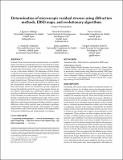Por favor, use este identificador para citar o enlazar a este item:
http://hdl.handle.net/10261/209387COMPARTIR / EXPORTAR:
 SHARE
BASE SHARE
BASE
|
|
| Visualizar otros formatos: MARC | Dublin Core | RDF | ORE | MODS | METS | DIDL | DATACITE | |

| Título: | Determination of microscopic residual stresses using diffraction methods, EBSD maps, and evolutionary algorithms |
Autor: | Hidalgo, Ignacio; Fernández, Ricardo CSIC ORCID CVN; Colmenar, J. M.; Garnica, Oscar; Lanchares, Juan; González-Doncel, Gaspar | Palabras clave: | Aluminium alloys Multi-objective optimization EBSD maps |
Fecha de publicación: | 15-jul-2019 | Citación: | GECCO '19 | Resumen: | Residual stresses, both macroscopic and microscopic, are originated during conventional metallurgical processes. Knowing their magnitude and distribution is of great importance in the structural design of applications where fatigue, stress corrosion or thermal cycling occur (e.g., in the aerospace industry). The importance of these stresses is reflected in the large number of articles published in recent years, mainly focused on studying macroscopic stresses. However, there are no experimental studies that quantify the magnitude of microscopic triaxial stresses. This lack is due in part to the limitations of diffraction techniques (neutrons and synchrotron radiation). Since the measurement volume is much higher than the variation of these microscopic stresses, its calculation is greatly complicated, because the methods used in the case of macroscopic stresses are not valid for microscopic ones. Furthermore, there is no reliable procedure to obtain the relaxed lattice parameter value, a key factor in the calculation of residual stresses. The aim of this paper is to present the main ideas oriented to develop a methodology for mapping microscopic stresses, particularly in aluminium alloys such as those commonly used in the aerospace industry. The procedure will use experimental diffraction results obtained from large European facilities, mainly by neutron diffraction. This information will be analyzed using evolutionary algorithms, computational techniques that handle a large number of variables. The procedure will be based on the analysis of the shift of the diffraction peaks and, fundamentally, their broadening. For simplicity, non-heat treatable alloys will be used as they do not experience lattice parameter variation with heat treatments. | Descripción: | Proceedings of the Genetic and Evolutionary Computation Conference Companion | Versión del editor: | https://doi.org/10.1145/3319619.3326769 | URI: | http://hdl.handle.net/10261/209387 |
| Aparece en las colecciones: | (CENIM) Comunicaciones congresos |
Ficheros en este ítem:
| Fichero | Descripción | Tamaño | Formato | |
|---|---|---|---|---|
| Determination of microsc_GGonzález.pdf | 472,16 kB | Adobe PDF |  Visualizar/Abrir |
CORE Recommender
Page view(s)
112
checked on 26-abr-2024
Download(s)
190
checked on 26-abr-2024
Google ScholarTM
Check
NOTA: Los ítems de Digital.CSIC están protegidos por copyright, con todos los derechos reservados, a menos que se indique lo contrario.
